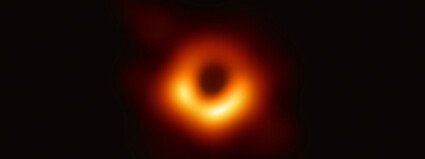Stars over Sisters 7/02/2019
Last updated 7/2/2019 at Noon

courtesy NASA
First image taken of a black hole (in galaxy M37) by Event Horizon Telescope Collaboration.
This past spring black holes made history when scientists published the first picture ever taken of a black hole in galaxy M87.
A black hole is a region of space-time exhibiting gravitational acceleration so strong that nothing can escape from it, not even particles or electromagnetic radiation. A black hole squeezes matter into an infinitesimally small space and is black because not even light can escape it. We can’t see black holes, but space telescopes with special tools can help us find them, as was done with the Event Horizon Telescope Collaboration.
We can identify a black hole by observing how the stars around it act. Black holes can be any size. Scientists think that there are some as small as an atom, but as dense as a mountain. The largest black holes are called supermassive, with a mass of one million suns put together. Stellar black holes are created when a star collapses on itself in a supernova.
A supermassive black hole is at the center of our Milky Way Galaxy, which from our perspective is in the direction of the constellation Sagittarius. The recent image of the black hole in M87 was not of the black hole itself, but of the things around it being affected by the black hole, showing its silhouette against the surroundings. The galaxy M87 is one of the most massive galaxies we can observe. With a telescope, you can find M87 in the constellation Virgo, currently visible in the evening sky.
Another constellation to explore during July is Corona Borealis. Corona Borealis means the “northern crown” in Latin. This small constellation appears as a half-ring of stars and was first catalogued by the Greek astronomer Ptolemy in the 2nd century. Corona Borealis lies between the constellations Bootes and Hercules.
With warm clear nights, July is a perfect time to observe the moon changing phases. Moon phases are created by the shifting positions of the earth, sun and moon. The moon’s apparent shape changes depending on how much sunlight reaches it.
This month is an exciting time to see both lunar and solar eclipses from South America. It begins with a new moon on July 2, which will shadow the sun in a total solar eclipse visible from Chile and Argentina. The moon will wax from crescent to first quarter on July 9. It will wax through the gibbous phase, reaching full on July 16 at 2:38 p.m., and if you are in South America, Africa, Europe, Asia, Australia, or Antarctica you can view a partial lunar eclipse. The moon will wane through the third quarter on July 23, and end the month with another new moon on July 31.
When you look at the night sky and see a stationary, bright object that doesn’t twinkle, you are most likely observing a planet, and July is a fantastic month to see the planets. Mercury is visible in the western evening sky until July 11. Mars can also be viewed right after sunset in the southwest until July 18.
Jupiter is visible the whole month traveling from east to west across the southern night sky just above Antares, the brightest red star in Scorpius.
Saturn chases Jupiter across the sky, shining just above the teapot of Sagittarius and rising and setting about two hours after Jupiter.
Pluto will also be chasing Sagittarius and can be seen with a telescope.
Uranus and Neptune can also be found with a telescope after midnight.
If you are interested in using telescopes or simply learning more about the night sky and sharing excitement about the stars, join the Stars Over Sisters Community Star Party at Sisters Park & Recreation District in the Sisters High School west parking lot on July 27 at 9?p.m.
It is open to the public and free of charge.
















Reader Comments(0)